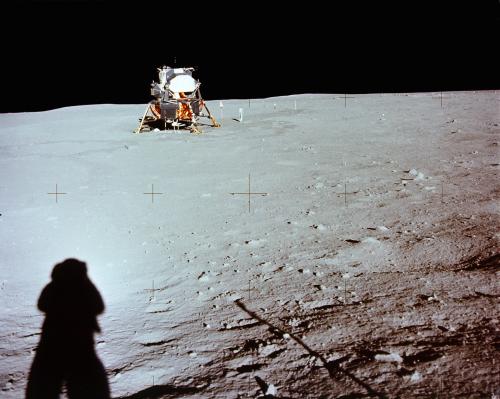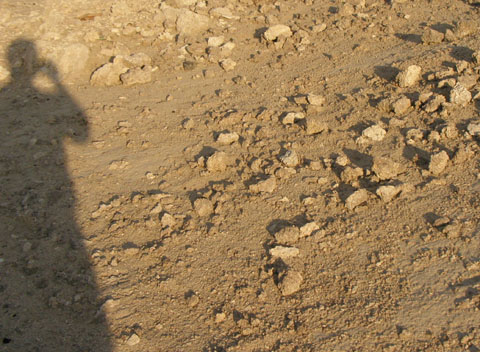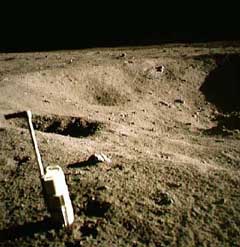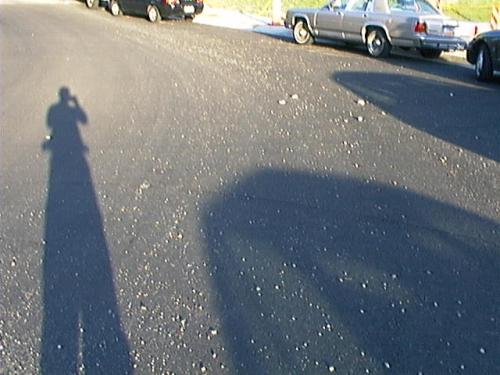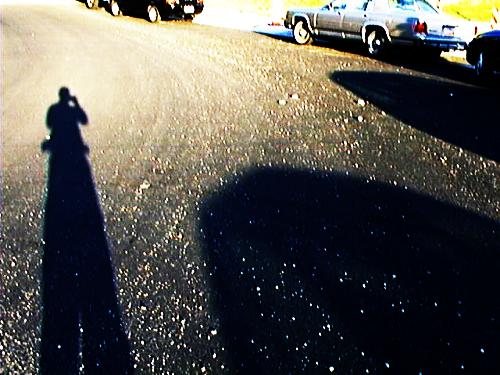converging shadows







|
|
|
An easily-seen feature of perspective is its tendency to make shadows appear more horizontal the farther they are away from the viewer. This affects many of the photographs conspiracists say show anomalous shadows.
|
 In a real photograph,
perspective requires the shadow to point to the photographer's feet,
which must be underneath the horizontal center of the frame. [Colin
Rourke (Aulis PDF), after Jack White and John
Costella]
In a real photograph,
perspective requires the shadow to point to the photographer's feet,
which must be underneath the horizontal center of the frame. [Colin
Rourke (Aulis PDF), after Jack White and John
Costella]
Neither Rourke nor White and Costella before him offers any sort of example, argument, computation, or line of reasoning for this assertion. In fact there is no such "rule" of perspective. Figs. 2 and 4 were specifically taken to address this claim and show photographer shadows that align with the left edge of the frame.
 Yes, terrain and camera
rotation affect the appearance of the shadow, but the terrain here is
flat and the cammera cannot be rotated because it is fixed to the
"breastplate." [Rourke, Ibid.]
Yes, terrain and camera
rotation affect the appearance of the shadow, but the terrain here is
flat and the cammera cannot be rotated because it is fixed to the
"breastplate." [Rourke, Ibid.]
No, this famous photograph was taken from the rim of Little West crater. The ground slopes downward and away to the left. What Rourke inaccurately calls the "breastplate" is the RCU, the remote control unit for the space suit equipment. Contrary to popular belief, it hung loosely from the backpack straps on two hooks. There was ample play in the mounting hardware to aim the camera.
 Perspective cannot
explain the extreme angle of the shadow at bottom center.
Perspective cannot
explain the extreme angle of the shadow at bottom center.
Probably not, but in analyzing photographs one cannot presume that the object casting it is perfectly vertical. Objects will only cast parallel shadows if they themselves are parallel along the line of illumination. As seen in Fig. 3, which was taken just prior to Fig. 1, the close-up surface camera, whose handle is casting the shadow in Fig. 1, is tilted at an angle.
 There is a peculiar
halo around the shadow of the astronaut's head. This is obviously a
"hot spot" caused by studio light meant to emphasize the
shadow.
There is a peculiar
halo around the shadow of the astronaut's head. This is obviously a
"hot spot" caused by studio light meant to emphasize the
shadow.
It would be strange to introduce such an artificial lighting scenario in a photograph intended to depict a natural circumstance. In fact the "halo" is the response of the textured lunar surface to a phase angle of zero. At that point in the photograph, the photographer is looking right down the direction from which the light is coming, hence his shadow. The shadows of objects -- rocks, craters, grains of dust -- are being hidden by the objects themselves.
This, instead, confirms that sunlight is the only significant source of light in this photograph. You do not get such phase-dependent effects from studio lighting of any kind.
|
|
Fig. 5 has been modified by adjusting the contrast digitally. This artificially amplifies the difference between light and shadow. Because scenes on Earth are also lit by light scattered by the atmosphere, it is impossible to duplicate exactly on Earth using only sunlight the lighting conditions on the moon. This contrast-enhancing technique gives more visual emphasis to shadows cast directly by the sun and de-emphasizes the effect of scattered light. It is not intended to exactly duplicate sunlighting on the moon.
Notwithstanding the inaccuracy of the approximation, the same optical principles produce a "halo" around the photographer in Fig. 5, for the same reason. The roadway is textured according to normal asphalt concrete construction, and at low sun angles the shadows cast by elements of that texture have a cumulative effect that is increasingly visible as phase angle increases. At a phase angle of 0°, none of those shadows can be seen, and the cumulative effect is that of a zone of increased brilliance.
It's not just an optical illusion. There actually is more lighting reaching the camera from that part of the surface than from other parts. This is the "zero phase angle effect" which renders the full moon four times brighter than a half moon, as seen from earth.
The camera is tilted downward in Figs. 4 and 5 more than in Fig. 1. In Fig. 1 the optical axis is at a shallower angle than the illumination angle. In Figs. 4 and 5 the optical axis is deeper than the illumination angle. Nevertheless a reasonably representative set of lines of sight can be correlated between the photos.
